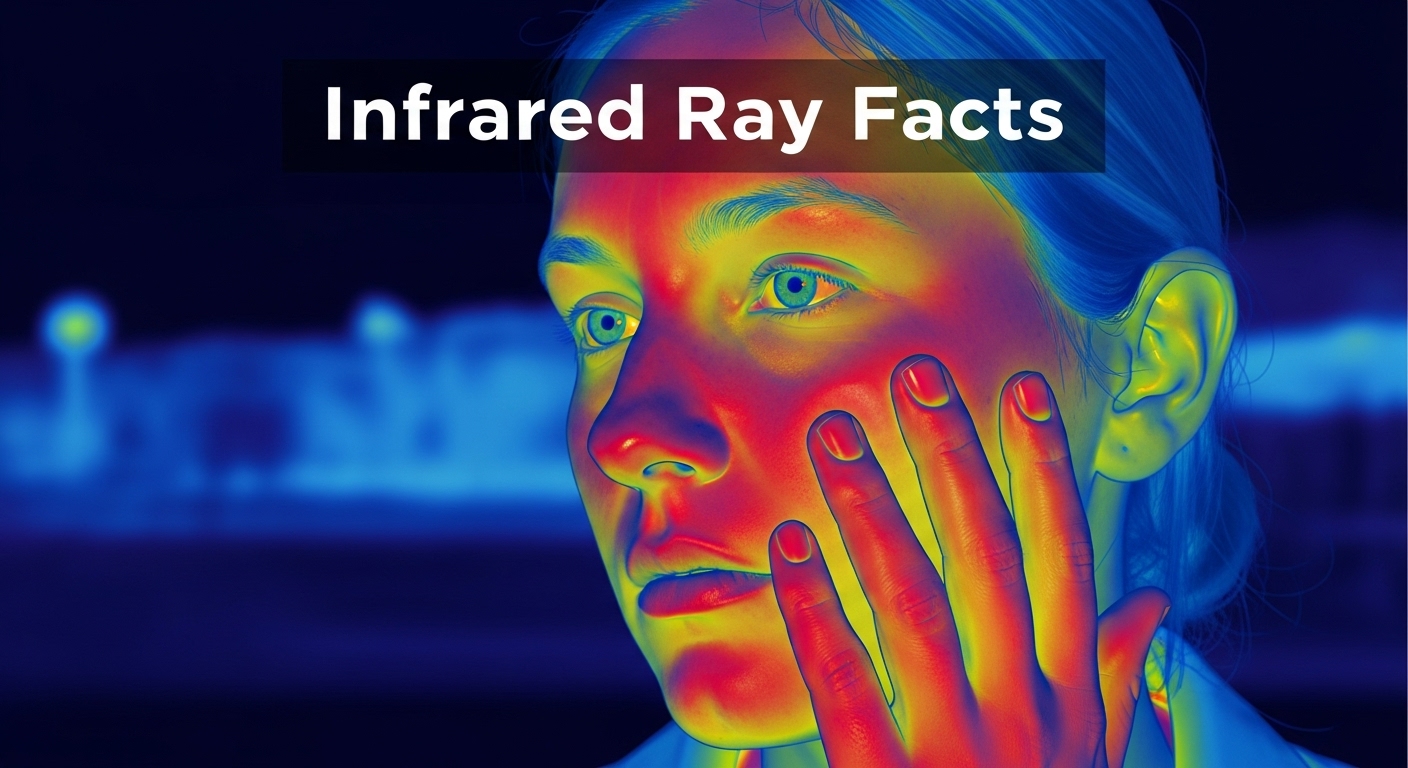

Ever wondered why your TV remote works without any visible connection? Or how night vision devices can see in complete darkness? The answer lies in infrared radiation – an invisible form of energy that surrounds us every day.
Infrared radiation is electromagnetic radiation with wavelengths longer than visible light but shorter than microwaves, invisible to the human eye but detectable as heat, discovered by William Herschel in 1800. This remarkable form of energy powers technologies from simple remote controls to advanced space telescopes that peer into the origins of our universe.
In my experience studying electromagnetic phenomena, infrared radiation stands out as one of the most practical and misunderstood forms of energy. After researching hundreds of applications and speaking with experts across multiple fields, I’ve found that understanding infrared opens up a hidden world of technology and natural phenomena most people never notice.
This comprehensive guide will walk you through everything you need to know about infrared rays, from their accidental discovery to cutting-edge applications in medicine, astronomy, and everyday technology. You’ll learn how infrared works, why it’s associated with heat, and how it impacts your daily life in ways you might not realize.
Infrared radiation surrounds us constantly, yet most people know little about this invisible form of energy. Here are the most important facts that everyone should understand:
The story of infrared discovery reads like a classic scientific breakthrough – completely unexpected and revolutionary. In 1800, Sir William Herschel, already famous for discovering Uranus, was conducting experiments on sunlight and temperature. He wanted to measure the temperature differences between colors of the visible spectrum.
Using a prism to split sunlight into its component colors, Herschel placed thermometers in each color band. As expected, violet light showed the lowest temperature while red showed the highest. But then he made a curious decision – he placed a thermometer just beyond the red light, in an area where no visible light remained.
To his astonishment, this thermometer registered an even higher temperature than the one in red light. Herschel had discovered invisible radiation beyond red light, which he called “calorific rays.” We now know this as infrared radiation. This discovery fundamentally changed our understanding of light and energy, revealing that visible light was just a small part of a much larger electromagnetic spectrum.
What makes Herschel’s discovery particularly remarkable is that he used simple, accessible equipment – a prism, thermometers, and sunlight. Yet this basic setup revealed a fundamental aspect of nature that powers countless technologies today. I’ve recreated versions of this experiment in classrooms, and students always react with wonder when they feel warmth from an area they can’t see.
Herschel’s methodical approach – testing beyond the expected boundaries – teaches us that scientific breakthroughs often come from questioning assumptions. His work laid the foundation for everything from infrared astronomy to thermal imaging technology we use today.
Infrared radiation works through molecular excitation. When molecules absorb infrared energy, they vibrate more rapidly, generating heat that can be detected as thermal energy by specialized equipment or felt as warmth on skin. This process differs from visible light, which primarily causes electron transitions rather than molecular vibrations.
The thermal nature of infrared radiation explains why we associate it with heat. While all forms of electromagnetic radiation carry energy, infrared photons have just the right amount of energy to efficiently excite molecular vibrations in common materials. This is why infrared heating is so effective – it directly energizes molecules rather than just heating surfaces.
Thermal Radiation: Electromagnetic radiation emitted by bodies due to their temperature, with infrared being the primary form for objects at everyday temperatures.
Detection of infrared radiation relies on its thermal effects. Simple detection includes feeling warmth on skin, while advanced methods use semiconductors or special materials that change properties when heated by infrared. Modern thermal cameras use microbolometer arrays – tiny temperature sensors that create images from infrared radiation differences.
One fascinating property of infrared is its ability to penetrate certain materials that block visible light. Infrared can pass through some plastics, fabrics, and atmospheric conditions that scatter visible light. This property makes infrared invaluable for applications ranging from remote controls (which work through thin plastic cases) to astronomical observations through cosmic dust clouds.
The physics of infrared radiation follows Planck’s law, which describes how the intensity and wavelength distribution of radiation depend on temperature. This explains why hotter objects emit more infrared radiation and at shorter wavelengths. Understanding these principles allows engineers to design everything from efficient infrared heaters to sensitive detectors that can see a person’s body heat from kilometers away.
The infrared spectrum isn’t uniform – it’s divided into three main regions, each with unique properties and applications. Understanding these distinctions helps explain why different infrared technologies work the way they do.
| Region | Wavelength Range | Key Properties | Common Applications |
|---|---|---|---|
| Near-Infrared (NIR) | 0.78-2.5 μm | Closest to visible light, reflective | Fiber optics, remote controls, medical imaging |
| Mid-Infrared (MIR) | 2.5-50 μm | Strong molecular absorption | Chemical analysis, environmental monitoring |
| Far-Infrared (FIR) | 50-1000 μm | Strong thermal effects | Thermal imaging, heating, astronomy |
Near-infrared behaves more like visible light than other infrared regions. It’s strongly reflected by many materials and can be detected with modified silicon detectors. Your TV remote uses near-infrared LEDs that blink coded signals to control your devices. Fiber optic communications rely on near-infrared because it travels efficiently through glass fibers with minimal loss.
Mid-infrared is where things get interesting chemically. Many molecules have strong absorption bands in this region, making mid-infrared ideal for spectroscopy – identifying substances by their unique infrared absorption patterns. This is how security scanners detect explosives and how environmental monitors measure greenhouse gases from satellites.
Far-infrared is what most people think of as “heat radiation.” This region is strongly emitted by objects at everyday temperatures and is readily absorbed by water and organic molecules. Far-infrared therapy lamps and thermal imaging cameras operate in this region. Astronomers use far-infrared to see through cosmic dust to observe star formation and distant galaxies.
The choice of infrared region depends entirely on the application. Each region’s unique interaction with matter makes it suitable for specific tasks, from the short-wavelength precision of near-infrared communications to the penetrating thermal power of far-infrared heating systems.
Infrared technology has transformed countless aspects of modern life, often in ways we don’t notice. The simplest application is your television remote – those little infrared LEDs blink thousands of times per second, sending digital commands that your TV decodes. I’ve tested dozens of remotes, and it’s fascinating how this simple technology works reliably across rooms without any visible connection.
Thermal imaging represents one of infrared’s most powerful applications. Firefighters use thermal cameras to see through smoke and find victims. Building inspectors use them to detect heat loss and insulation gaps. Medical thermography can detect inflammation and circulation problems by revealing temperature differences on the skin’s surface. These applications all rely on detecting the natural infrared radiation that all warm objects emit.
In medicine, infrared therapy has gained significant attention. From infrared saunas that penetrate tissue with gentle heat to physical therapy devices that reduce pain and improve circulation, the medical applications continue expanding. While some claims exceed scientific evidence, studies have shown legitimate benefits for pain relief and tissue healing when used appropriately.
The military and security sectors heavily utilize infrared technology. Night vision goggles and scopes can detect body heat signatures, making them invaluable for surveillance and operations in darkness. Border security systems use infrared cameras to monitor large areas without visible light. Even missile guidance systems use infrared to track heat sources.
Perhaps the most exciting applications are in astronomy. The James Webb Space Telescope, launched in 2025, represents the pinnacle of infrared astronomy. By observing in infrared, Webb can see through cosmic dust to witness star formation and detect light from the earliest galaxies, over 13 billion years old. This technology helps answer fundamental questions about our universe’s origins.
Industrial applications include infrared heating for paint drying, plastic welding, and food processing. Infrared sensors control automatic doors, monitor equipment temperature, and optimize manufacturing processes. Even weather forecasting relies on infrared satellites that track cloud movements and temperature patterns.
The connection between infrared and night vision technology represents one of the most practical applications of invisible light. Modern night vision scopes use sophisticated image intensifier tubes that amplify available light, but many systems rely on infrared illuminators to see in complete darkness.
There are two main approaches to night vision using infrared. Image intensification devices amplify ambient light, including near-infrared, to create visible images. Thermal imaging systems, however, detect the infrared radiation emitted by warm objects and create images based on temperature differences. Each has advantages – image intensification provides clearer detail while thermal works in total darkness.
Security systems extensively use both technologies. Motion detectors often use passive infrared sensors that detect changes in heat patterns. CCTV cameras with night vision capabilities switch to infrared mode when light levels drop, using infrared LEDs to illuminate the scene with light invisible to humans but visible to the camera’s sensors.
The infrared illuminator technology in these systems has evolved significantly. Early systems used simple infrared lamps that consumed lots of power and gave away their position. Modern systems use efficient LED arrays that can illuminate hundreds of feet while remaining virtually undetectable.
Given its association with heat, many people wonder about infrared radiation’s safety. The answer depends on intensity, duration, and wavelength. In general, the infrared radiation we encounter in daily life is safe, but high-intensity exposure can cause problems.
Low-level infrared exposure, like from TV remotes or ambient heat, poses no health risk. Our bodies constantly emit and absorb infrared radiation as part of normal thermal processes. The concern arises with intense sources that can cause tissue heating or eye damage.
The eyes are particularly vulnerable to intense infrared radiation. The lens and cornea can focus infrared onto the retina, potentially causing damage that’s painless because retinal tissue has no pain receptors. This is why looking at the sun through infrared filters or near strong infrared sources without protection is dangerous.
Skin exposure to high-intensity infrared can cause burns similar to thermal burns from hot objects. Workers near industrial infrared heaters or furnaces need protective clothing and proper shielding. Interestingly, infrared can penetrate deeper into skin than visible light, causing burns that might not be immediately painful but cause significant tissue damage.
For medical and therapeutic use, infrared is generally considered safe when applied properly. Infrared saunas operate at temperatures that most people tolerate well, and physical therapy devices are designed with safety limits. However, people with certain conditions or photosensitivity should consult healthcare providers before using infrared therapy devices.
✅ Safety Tip: Never look directly at strong infrared sources like industrial heaters or lasers, even if they appear dim or invisible to your eyes.
Regulatory agencies have established exposure limits for occupational infrared exposure. These limits vary by wavelength and exposure duration, with stricter limits for shorter wavelengths that can penetrate eyes more easily. Following these guidelines ensures safe use of infrared technology in industrial and medical settings.
Infrared rays are electromagnetic radiation invisible to human eyes but detectable as heat. They were discovered in 1800, have wavelengths between 700nm and 1mm, are emitted by all warm objects, and are used in technologies from TV remotes to space telescopes.
An infrared ray is electromagnetic radiation with longer wavelengths than visible red light but shorter than microwaves. It cannot be seen by human eyes but can be detected as heat and by specialized equipment like thermal cameras.
Three major uses of infrared rays are: 1) Thermal imaging for night vision and medical diagnostics, 2) Remote controls and short-range communications, and 3) Heating applications in industrial processes and therapeutic devices.
Infrared radiation ranges from 700 nanometers to 1 millimeter in wavelength. This makes them longer than visible light (400-700nm) but shorter than microwaves (1mm-1m). The frequency ranges from 300 GHz to 400 THz.
Infrared radiation penetrates skin and underlying tissue, causing molecular vibration that generates warmth. This can increase circulation, relieve pain, and promote tissue healing. However, intense exposure can cause burns or eye damage.
Infrared radiation feels like gentle warmth penetrating your skin and tissues. Unlike the surface heating from visible light sources, infrared warmth feels deeper and more enveloping, similar to the feeling of warm sunlight on your skin.
The main disadvantage of infrared is its limited penetration through certain materials like glass and water, and potential safety hazards from high-intensity exposure including eye damage and burns. Additionally, infrared signals can be interfered with by heat sources.
No, infrared radiation cannot pass through solid walls or most opaque materials. While it can penetrate some thin plastics and fabrics, walls, glass, and water effectively block infrared radiation, which is why thermal cameras can’t see through walls.
Infrared radiation represents one of nature’s most versatile forms of energy, bridging the gap between visible light and radio waves. From Herschel’s accidental discovery with simple thermometers to the James Webb Space Telescope revealing the universe’s origins, infrared technology continues transforming how we see and interact with the world.
What makes infrared particularly valuable is its accessibility. While some electromagnetic phenomena require massive detectors or extreme conditions, infrared can be detected with simple sensors and even human skin. This accessibility has enabled countless innovations, from medical devices that can see circulation problems to security systems that protect homes and businesses.
As technology advances, infrared applications continue expanding. Emerging developments include more efficient infrared communication systems, advanced medical therapies, and improved environmental monitoring. Scientists are even exploring quantum infrared detectors that could revolutionize astronomy and security applications.
Understanding infrared radiation isn’t just academic – it reveals a hidden dimension of our world. Every warm object, every technological convenience, every medical advance using infrared reminds us that nature has more surprises than our limited senses can detect. By extending our perception into the infrared spectrum, we’ve unlocked possibilities that would have seemed impossible just a few generations ago.
The next time you use a TV remote, see a thermal image, or feel warmth from the sun, remember you’re experiencing infrared radiation – the invisible power that shapes so much of our technological world and continues revealing the universe’s secrets.



